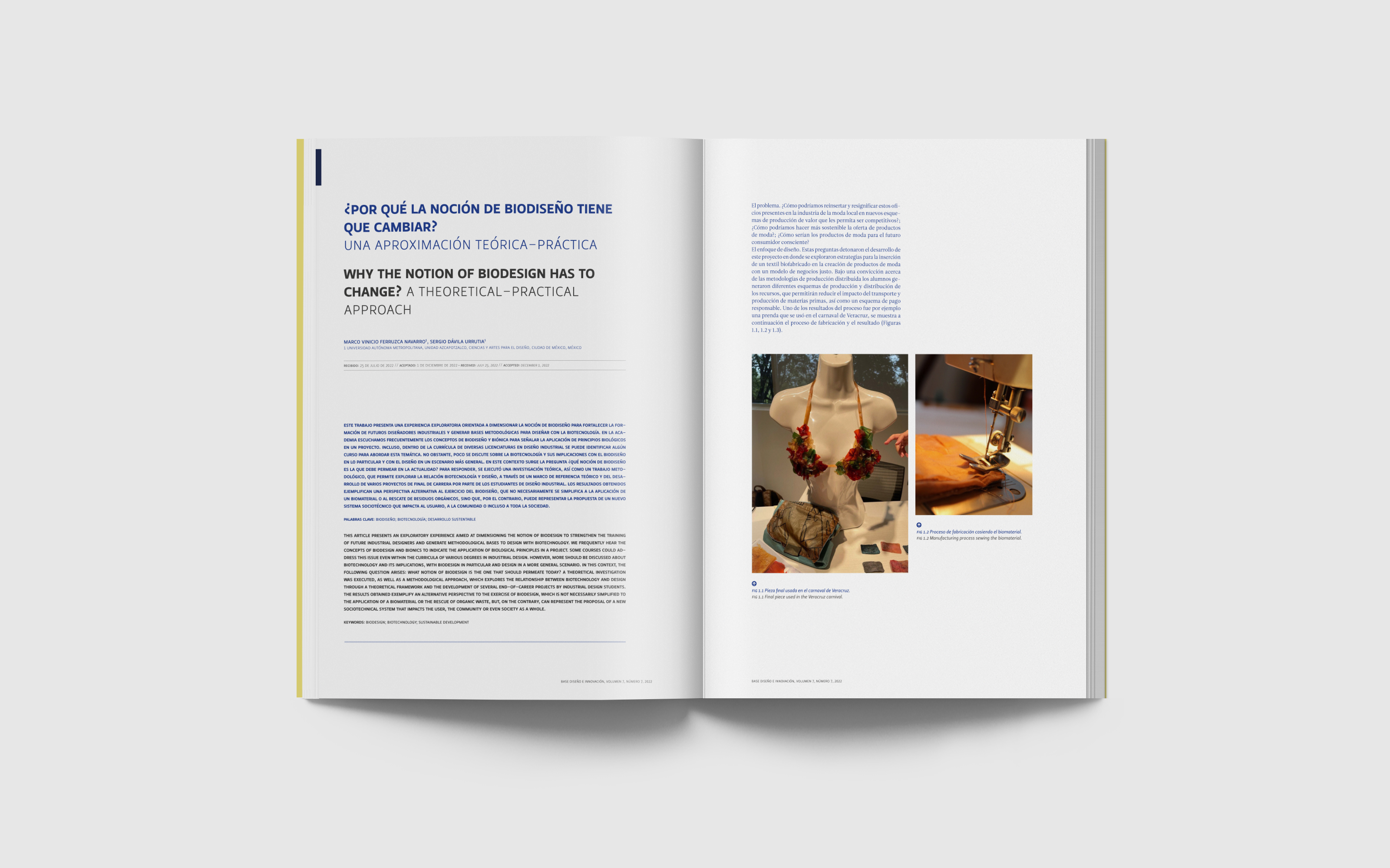Why the notion of biodesign has to change? A theoretical-practical approach
Main Article Content
Abstract
This article presents an exploratory experience aimed at dimensioning the notion of biodesign to strengthen the training of future industrial designers and generate methodological bases to design with biotechnology. We frequently hear the concepts of biodesign and bionics to indicate the application of biological principles in a project. Some courses could address this issue even within the curricula of various degrees in industrial design. However, more should be discussed about biotechnology and its implications, with biodesign in particular and design in a more general scenario. In this context, the following question arises: What notion of biodesign is the one that should permeate today? A theoretical investigation was executed, as well as a methodological approach, which explores the relationship between biotechnology and design through a theoretical framework and the development of several end-of-career projects by industrial design students. The results obtained exemplify an alternative perspective to the exercise of biodesign, which is not necessarily simplified to the application of a biomaterial or the rescue of organic waste, but, on the contrary, can represent the proposal of a new sociotechnical system that impacts the user, the community or even society as a whole.
Article Details
References
Antuñano, J. S., Gutiérrez, M. L., Dussel, E., Ocejo, T., Toca, A., Carmona, M. S. y otros. (1992). Contra un diseño dependiente: un modelo para la autodeterminación nacional. Universidad Autónoma Metropolitana, Azcapotzalco. División de Ciencias y Artes para el Diseño.
Arruda, A., & Langella, C. (2021, August 31). Prólogo. BioDiseño, Innovación y Transdisciplinariedad. Cuadernos del Centro de Estudios de Diseño y Comunicación 140. https://doi.org/10.18682/cdc.vi140.5098
Ávila, M., Dilnot, C., & Staszowski, E. (2022). Designing for Interdependence. A Poetics of Relating. Bloomsbury Visual Arts.
Biodesign Challenge (s.f.). https://www.biodesignchallenge.org/
Di Bella, D. V. (2021). Prefacio. Cuadernos del Centro de Estudios de Diseño y Comunicación 149. https://doi.org/10.18682/cdc.vi149.5513
Escobar, A. (2018). Designs for the Pluriverse: Radical Interdependence, Autonomy, and the Making of Worlds. Duke University Press.
Ferruzca, M. V., Dávila, S., & Andrade, C. S. (2022). Fortalecimiento de la formación de Diseñadores Industriales para entender la biotecnología, Cuadernos del Centro de Estudios de Diseño y Comunicación 166. https://doi.org/10.18682/cdc.vi166.7047
Galán, B. (2011). Diseño, proyecto y desarrollo. Miradas del período 2007-2010 en Argentina y Latinoamérica. Wolkowicz Editores.
Garret, C. (2022). Greenwashing: definición y ejemplos. https://climate.selectra.com/es/que-es/greenwashing
Goidea, A., Floudas, D., & Andréen, D. (2022). Transcalar design: An approach to Biodesign in the built environment. Infrastructures, 7(4), 50. https://doi.org/10.3390/infrastructures7040050
Haraway, D. J. (2016). Staying with the Trouble: Making Kin in the Chthulucene. Duke University Press Books.
Iyer, P., & Bezamat, F. (2021, December 22). How to speed up the biomanufacturing revolution. World Economic Forum. https://www.weforum.org/agenda/2021/12/how-to-fuel-the-biomanufacturing-revolution/
Manzini, E. (2015). Design, When Everybody Designs: An Introduction to Design for Social Innovation. The MIT Press.
Master’s Programme in Design Ecologies - Konstfack. (s.f). Retrieved October 5, 2022, from https://www.konstfack.se/en/Education/Masters-Degree-Programmes/Masters-programme-Design-Ecologies/
Maturana, H. (1995). La Realidad: ¿Objetiva o Construída?. I Fundamentos Biológicos del Conocimiento. Anthropos.
Santos, B. D. S. (2009). Una epistemologia del sur: la reinvencion del conocimiento y la emancipacion social. Consejo Latinoamericano de Ciencias Sociales, Siglo XXI.


